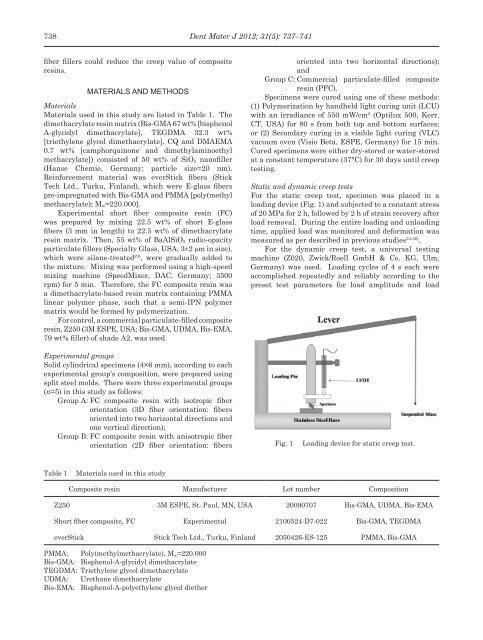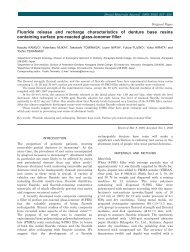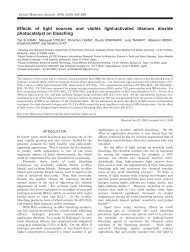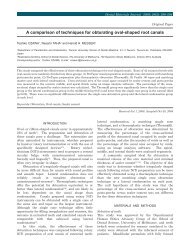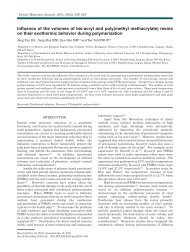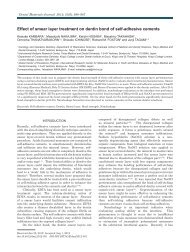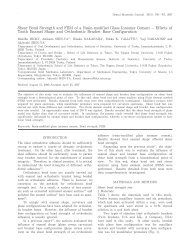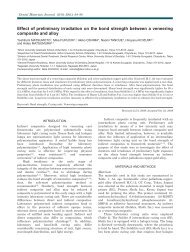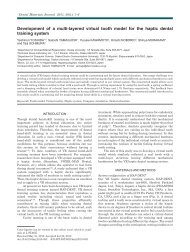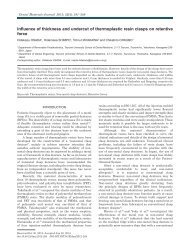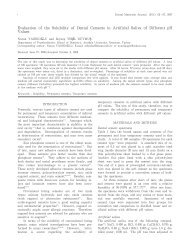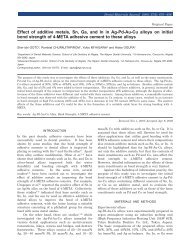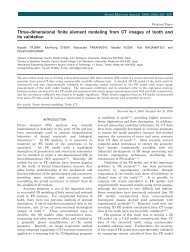Creep of experimental short fiber-reinforced composite resin
Creep of experimental short fiber-reinforced composite resin
Creep of experimental short fiber-reinforced composite resin
You also want an ePaper? Increase the reach of your titles
YUMPU automatically turns print PDFs into web optimized ePapers that Google loves.
738 Dent Mater J 2012; 31(5): 737–741<br />
<strong>fiber</strong> fillers could reduce the creep value <strong>of</strong> <strong>composite</strong><br />
<strong>resin</strong>s.<br />
MATERIALS AND METHODS<br />
Materials<br />
Materials used in this study are listed in Table 1. The<br />
dimethacrylate <strong>resin</strong> matrix (Bis-GMA 67 wt% [bisphenol<br />
A-glycidyl dimethacrylate], TEGDMA 32.3 wt%<br />
[triethylene glycol dimethacrylate], CQ and DMAEMA<br />
0.7 wt% [camphorquinone and dimethylaminoethyl<br />
methacrylate]) consisted <strong>of</strong> 50 wt% <strong>of</strong> SiO 2 nan<strong>of</strong>iller<br />
(Hanse Chemie, Germany; particle size=20 nm).<br />
Reinforcement material was everStick <strong>fiber</strong>s (Stick<br />
Tech Ltd., Turku, Finland), which were E-glass <strong>fiber</strong>s<br />
pre-impregnated with Bis-GMA and PMMA [poly(methyl<br />
methacrylate); M w=220.000].<br />
Experimental <strong>short</strong> <strong>fiber</strong> <strong>composite</strong> <strong>resin</strong> (FC)<br />
was prepared by mixing 22.5 wt% <strong>of</strong> <strong>short</strong> E-glass<br />
<strong>fiber</strong>s (3 mm in length) to 22.5 wt% <strong>of</strong> dimethacrylate<br />
<strong>resin</strong> matrix. Then, 55 wt% <strong>of</strong> BaAlSiO 2 radio-opacity<br />
particulate fillers (Specialty Glass, USA; 3±2 μm in size),<br />
which were silane-treated 23) , were gradually added to<br />
the mixture. Mixing was performed using a high-speed<br />
mixing machine (SpeedMixer, DAC, Germany; 3500<br />
rpm) for 5 min. Therefore, the FC <strong>composite</strong> <strong>resin</strong> was<br />
a dimethacrylate-based <strong>resin</strong> matrix containing PMMA<br />
linear polymer phase, such that a semi-IPN polymer<br />
matrix would be formed by polymerization.<br />
For control, a commercial particulate-filled <strong>composite</strong><br />
<strong>resin</strong>, Z250 (3M ESPE, USA; Bis-GMA, UDMA, Bis-EMA,<br />
79 wt% filler) <strong>of</strong> shade A2, was used.<br />
oriented into two horizontal directions);<br />
and<br />
Group C: Commercial particulate-filled <strong>composite</strong><br />
<strong>resin</strong> (PFC).<br />
Specimens were cured using one <strong>of</strong> these methods:<br />
(1) Polymerization by handheld light curing unit (LCU)<br />
with an irradiance <strong>of</strong> 550 mW/cm 2 (Optilux 500, Kerr,<br />
CT, USA) for 80 s from both top and bottom surfaces;<br />
or (2) Secondary curing in a visible light curing (VLC)<br />
vacuum oven (Visio Beta, ESPE, Germany) for 15 min.<br />
Cured specimens were either dry-stored or water-stored<br />
at a constant temperature (37°C) for 30 days until creep<br />
testing.<br />
Static and dynamic creep tests<br />
For the static creep test, specimen was placed in a<br />
loading device (Fig. 1) and subjected to a constant stress<br />
<strong>of</strong> 20 MPa for 2 h, followed by 2 h <strong>of</strong> strain recovery after<br />
load removal. During the entire loading and unloading<br />
time, applied load was monitored and deformation was<br />
measured as per described in previous studies 24-26) .<br />
For the dynamic creep test, a universal testing<br />
machine (Z020, Zwick/Roell GmbH & Co. KG, Ulm,<br />
Germany) was used. Loading cycles <strong>of</strong> 4 s each were<br />
accomplished repeatedly and reliably according to the<br />
preset test parameters for load amplitude and load<br />
Experimental groups<br />
Solid cylindrical specimens (4×6 mm), according to each<br />
<strong>experimental</strong> group’s composition, were prepared using<br />
split steel molds. There were three <strong>experimental</strong> groups<br />
(n=5) in this study as follows:<br />
Group A: FC <strong>composite</strong> <strong>resin</strong> with isotropic <strong>fiber</strong><br />
orientation (3D <strong>fiber</strong> orientation: <strong>fiber</strong>s<br />
oriented into two horizontal directions and<br />
one vertical direction);<br />
Group B: FC <strong>composite</strong> <strong>resin</strong> with anisotropic <strong>fiber</strong><br />
orientation (2D <strong>fiber</strong> orientation: <strong>fiber</strong>s<br />
Fig. 1<br />
Loading device for static creep test.<br />
Table 1<br />
Materials used in this study<br />
Composite <strong>resin</strong> Manufacturer Lot number Composition<br />
Z250 3M ESPE, St. Paul, MN, USA 20090707 Bis-GMA, UDMA, Bis-EMA<br />
Short <strong>fiber</strong> <strong>composite</strong>, FC Experimental 2100524-D7-022 Bis-GMA, TEGDMA<br />
everStick Stick Tech Ltd., Turku, Finland 2050426-ES-125 PMMA, Bis-GMA<br />
PMMA: Poly(methylmethacrylate), M w =220.000<br />
Bis-GMA: Bisphenol-A-glycidyl dimethacrylate<br />
TEGDMA: Triethylene glycol dimethacrylate<br />
UDMA: Urethane dimethacrylate<br />
Bis-EMA: Bisphenol-A-polyethylene glycol diether


